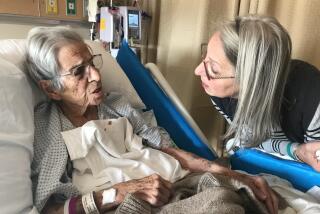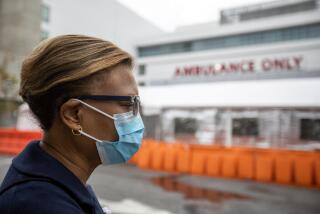St. John’s to Close 31-Bed Acute-Care Wing
- Share via
Dramatizing a countywide nursing shortage, St. John’s Regional Medical Center is closing one of its acute-care wings because it can no longer afford to hire expensive substitute nurses.
St. John’s also said Wednesday that it will hike the pay of its critical-care nurses by 24%, an increase that could ignite a bidding war for nurses with other hospitals in the county.
The Oxnard hospital is closing a wing despite treating record numbers of patients because a shortage of staff nurses has forced it to hire so many substitute caregivers that it is losing money, officials said.
But in hiking the pay of its highly skilled nurses by $5 an hour, the largest hospital in the county is taking the already stiff competition for nurses to a new level.
As word of the pay hike filtered out this week, nurses from other hospitals have called to see if they can fill one of St. John’s 22 vacancies.
“We are sympathetic to St. John’s position,” said Kris Carraway, spokeswoman for Los Robles Regional Medical Center in Thousand Oaks, which is also trying to fill dozens of vacant nursing jobs. “But you can’t help but ask yourself, ‘Are they creating a nursing war?’ ”
That may be the case, unfortunately, said Jim Hoss, St. John’s top administrator.
“I’m not a real popular person right now,” he said. “We’ve raised the bar here, and that’s created a certain amount of concern among our colleagues.”
St. John’s has created a stir among its own staff, as well, by announcing Friday that it would shut down a 31-bed wing at the 256-bed hospital because it can no longer afford to operate near capacity.
The move, administrators acknowledged, means that some patients will be forced to go to hospitals in other communities. Also, elective surgeries will be postponed, and some patients will find themselves waiting in the emergency room for beds to empty.
That will likely tarnish a reputation that St. John’s has polished since 1992, when it opened its $110-million campus on Rose Avenue.
“It’s a new world, a different world,” Hoss said. “But I don’t know how brave it is.
“We’ll have to struggle with the image the public has of long delays in the emergency room,” he said. “And people who have the choice, who have good insurance, may go elsewhere. We’re concerned about that.”
Fifteen occupied beds in the wing that is being closed will be taken out of service this week as patients leave, Hoss said. It has become too expensive to pay the double-time wages of temporary nurses.
Such nurses are hired from a so-called registry that functions like a substitute teacher pool. Those nurses demand $43 to $53 an hour, compared with St. John’s standard rate of $21 per hour.
Overall labor costs per patient in the affected wing have risen above $800 a day, compared to typical patient costs of about $500, he said.
*
Even at the reduced figure, St. John’s had made only about 1% to 1.5% profit, Hoss said. During the first eight months of this fiscal year, the hospital has lost money, he said.
“Managed-care [insurance] providers pay us a fixed amount per patient per diem without any consideration of these extra costs,” he said. “But the increased patient volume forces us to use the most expensive labor. So we’ve gotten squeezed.”
St. John’s has set records for patients nearly every month for at least 18 months, he said. “So we’re sort of a victim of our own success.”
But Hoss’ response to St. John’s nursing shortage and the accompanying financial crisis has already prompted protests.
Representatives of the hospital’s 45 emergency room nurses plan to meet with Hoss today to protest pay increases for some nurses, but not for them. And sickouts are planned for next week if Hoss does not grant increases for them, two emergency room nurses said in interviews.
All hospital nurses had received the same pay until this week. Now 27% of the 389 nurses make an extra $5 an hour. Those nurses work in wards where patients are critically ill or on monitors after they leave intensive care, officials said.
“Nurses in the E.R. have been treating intensive-care patients for up to five days waiting for beds to open up,” said one veteran nurse, who asked not to be identified. “We’ve had up to 13 intensive-care patients in here at one time.
“So we’re doing their job, but not being paid for it,” she said. “There are some brand-new nurses getting top dollar to work in those telemetry [monitored] units. But when their patients become critically ill, they’re sent back to E.R. for us to take care of until there’s an ICU bed open in a few days.”
*
Dr. Allen Hooper, head of St. John’s emergency room, said he is frustrated by the developments. He said he hates the idea of closing down beds when the community clearly needs them. But he said he could not offer a better solution to his hospital’s financial crisis.
“Our image will be tainted by this even though our long-term reasons for it are altruistic,” he said. “But because of our low reimbursement, we’re so deeply in the toilet, the hospital is at risk of going under financially. This is a short-term solution. But no one in this hospital is happy about it.”
The decisions at St. John’s will have widespread impact, said hospital industry spokesman Monty Clark in Ventura.
First, patients who would have gone to St. John’s will go elsewhere, he said. But hospitals countywide have been nearly full since December, he said. That has prompted unprecedented numbers of ambulance diversions to other hospitals because critical-care beds have been full.
Over the last two months alone, local hospitals have called ambulance diversions for 436 eight-hour periods. And even without the closure of a wing, St. John’s led the way with 110 diversions in January and February, according to county records.
“We’ve been having troubles with this nursing shortage at all of our hospitals,” Clark said. “If you can’t staff a particular unit with nurses, you have to go on diversion.”
The seven other general hospitals in Ventura County may have to match St. John’s elevated pay rate for critical-care nurses, he said.
“Everyone else is going to follow suit,” Clark said. “They’ll have to pay pretty much the same to get or keep their nurses.”
Last winter’s flu epidemic, which left every local hospital overflowing with patients but with too few nurses, had already prompted hospitals to offer better pay and benefits, more convenient work schedules and to pay for nurses’ continuing education.
The shortage exists partly because harried nurses--overworked after hospital cutbacks in the early 1990s--have retired, taken jobs with health maintenance organizations or moved into caring for patients at home.
At the same time, nursing schools are producing fewer highly trained graduates because managed-care cuts made it hard until recently for young nurses to get jobs. And women--92% of nurses--are increasingly choosing careers with better pay.
That has left Southern California’s 58 hospitals with 833 registered nursing vacancies, according to a recent study by an industry council. And more than 500 of those are in such highly specialized areas as critical care, labor and delivery, and operating rooms.
More to Read
Sign up for Essential California
The most important California stories and recommendations in your inbox every morning.
You may occasionally receive promotional content from the Los Angeles Times.













